Key Questions Addressed
What makes heating elements in ovens to fail?
How do one determine a failing oven heating element?
Could I fix a broken oven heating element myself?
What tools and materials are required for replacement?
How to ensure safe and efficient oven heating element repair?
What Makes Oven Heating Element Failments Possible?
Thermal stress, oxidation, or electrical overload cause heating elements in ovens to deteriorate. These are important stumbling blocks:
Thermal fatigue: Repeated expansion/contraction cycles (average 3-5 times daily) weaken nickel-chromium (NiCr) coils.
Ceramic-insulated components lose 5–10% conductivity yearly when humidity exceeds 60%.
Voltage spikes: 30% of lifespan is lost from abrupt surges above 10% of rated voltage (e.g., 120V → 132V).
Technical thresholds:
Maximum permitted deformation, per ASTM B862 criteria, is 0.8 mm bending radius.
For ceramic, safe operating temperatures are 1600°F (871°C); for NiCr, 1200°F (649°C).
Insulation resistance measure with 500V megohmmeter is ≥10MΩ.
According to 2023 research by the Appliance Repair Association, cracked ceramic bases were responsible for 68% of oven failures.
How should one diagnose a broken oven heating element?
Visual Inspection
Check for:
Cracks or blisters: >1mm cracks require replacement (causes arcing ≥50kA)
Discoloration: Blue/white oxidation spots indicate >30% conductivity loss
Loose terminals: Vibration causes ≤2° tilt, increasing resistance by 8%
Electrical Testing
(1),Resistance measurement:
Disconnect power and measure element resistance:
120V models: R = V²/P = (120)²/1500 ≈ 9.6Ω
Tolerance: ±5% (e.g., 1500W element: 9.1–10.1Ω)
Open circuit (>100MΩ) indicates breakage.
(2),Continuity test:
Multimeter should show <0.5Ω resistance (continuity mode beep).
(3),Insulation test:
Megohmmeter reading <1MΩ confirms ground faults.
Can I Repair a Broken Oven Heating Element Myself?
DIY repair steps (requires basic tools):
(1),Safety protocol:
Disconnect power (verify with voltage tester: ≤0.5V residual)
Discharge capacitors (1000μF+ types need 5-minute wait)
(2),Element removal:
Remove rear panel (5/16″ hex bit)
Disconnect terminals (twist-lock connectors rated ≥15A)
(3),Installation:
Align element with ±1mm tolerance (misalignment causes hotspots)
Torque screws to 15in-lbs (use calibrated wrench)
Reconnect power and test thermal uniformity (±15°F variance allowed)
Risks of DIY:
Incorrect torque → 25% higher failure rate within 6 months
Improper insulation → 10% risk of electric shock (≥5mA leakage current)
What Tools and Materials Are Required for Replacement?
| 項目 | Specification | Cost Range |
|---|---|---|
| Replacement element | NiCr alloy, 1200°F rating | 25–120 |
| Insulated screwdrivers | 1000V rated | 10–30 |
| Multimeter | True RMS, 50MHz | 50–200 |
| Thermal paste | Ceramic-based (1.5W/m·K) | 8–15 |
Pro tip: Use torque screwdrivers (±3% accuracy) for terminal fixation to prevent cold solder joints.

How to Ensure Safe and Efficient Oven Heating Element Repair?
Post-Repair Validation
(1),Thermal performance test:
Preheat to 350°F (177°C) within 15 minutes (spec: ≤17 minutes)
Surface temperature uniformity: ±20°F (measured via IR thermometer)
(2),Electrical validation:
Run 8-hour endurance test (resistance drift ≤3%)
Check error codes (e.g., F2 on Bosch ovens clears post-test)
(3),Safety certification:
UL 763 compliance verification
Ground fault current ≤0.5mA
について Zhongshan Jinhong Electric Heating Technology Co., Ltd.
As a leading oven heating element manufacturer, we provide:
Professional repair kits: Include pre-tested elements, torque tools, and instruction manuals
Technical support: 24/7 multilingual engineering assistance
Custom solutions: OEM-compatible elements with military-grade MIL-STD-810G certification
Core advantages:
48-hour rapid prototyping
Global certifications: CE, UL, GS, RoHS
Lifetime warranty on premium elements
References
UL 763 Standard for Electric Ovens and Ranges (2023 Edition)
ASTM B862 Nickel-Chromium Alloy Wire Specifications
Appliance Repair Association Technical Report AR-2023-09
Jinhong Electric R&D Manual JHE-RP-2023
NEMA Standards Publication MG 1-2022


